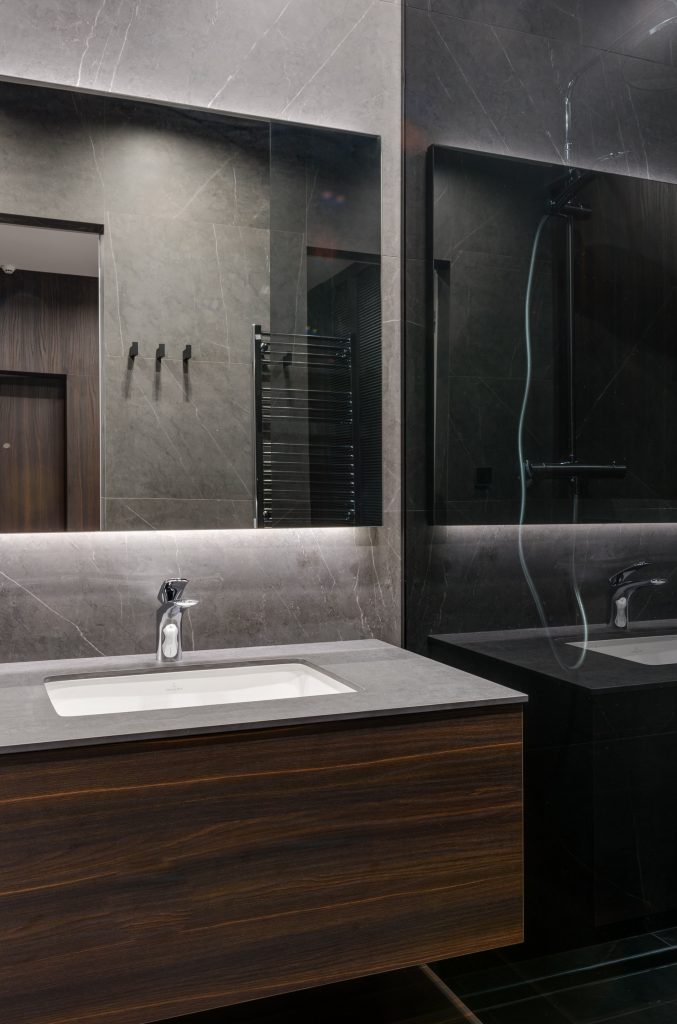
Don’t Miss Part 1
Applying Adhesive
The next step to install a clipless, frameless mirror requires some thoughtfulness. Adhesive is not easy to clean up once it’s been applied – especially not the kind strong enough to hold up a mirror. So, read the following carefully before you start.
Mark Your Intervals
To apply the adhesive, you’re going to create vertical lines of it. To ensure the weight of the mirror is evenly distributed, you’ll want to make those about the same distance apart. For a large mirror that’s more than about 3 feet wide, you’ll want your lines to be close to 4 inches apart. Smaller mirrors will get enough support from lines 5 or 6 inches apart.
You can make these exact by measuring the width of your mirror and doing some math, but exactness isn’t entirely necessary here. However, what is necessary is marking your intervals. Even if you’re only eyeing the adhesive intervals, having a guide for when you’re actually applying the hard-to-undo adhesive, is a great idea.
You can mark your intervals by marking a Point A and Point B at the top and bottom of the mirror zone, by making a few dashes, or by marking a solid line with a straight edge. They each work for differing levels of steady-handedness, so use what works best for you.
Important Note: Take into account, before making your marks, that you should leave a buffer. Make sure the marks on either side of your mirror zone are at least a couple inches from the edge. Otherwise, you may be able to see the adhesive when you’re done. The top and bottom are less likely to show. However, starting and ending your line an inch from the top and bottom of the mirror zone is smart, as it leaves room for spreading.
Apply Your Adhesive
When you’re done marking your intervals, it’s time to apply the adhesive. This part is straightforward. Make a solid, continuous, vertical line along each interval marking. If it doesn’t look super pretty, that’s fine. It’s all going to be hidden behind the mirror anyway.
Important Note: Something you absolutely need to know when applying your adhesive is that it’s vertical for a reason. Creating vertical lines that are left disconnected from each other allows air flow behind. Therefore, moisture will be unable to get behind it and create mold. For that reason, do not seal the edges with adhesive, connect the vertical lines, or create any horizontal lines.
Installing Your Mirror
Finally, we’ve reached the last step. This one is straightforward, but a tiny slipup could make a huge mess. Therefore, this step is the most simple in its explanation, and the most scary in its execution.
Have your friend pick up that Keystone mirror again and hold it up in front of the mirror zone markers. Get it pretty close – about 1-2 inches away. While your friend is holding the mirror up, take a moment to check if it’s lined up. Then, have them press the mirror to the adhesive. The adhesive is still malleable, if not sticky. Therefore, if it’s not perfectly lined up, you will have a few seconds to gently adjust it. Just be careful not to overcorrect in your haste, or it could make an adhesive mess.
Once the mirror is in place, put gentle pressure across all areas of the surface, securing it more effectively. Don’t aim to get it perfectly flush with the wall, as we do want there to be some airflow behind it. That was the last step to install a clipless, frameless mirror! Now, you wait. Give it 48 hours before doing more work around it, like installing lighting or erasing marking lines.

